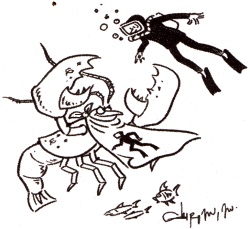Health Advisories
Statewide Estuarine & Marine Waters
All coastal waterbodies, except those under Waterbody Specific Advisories
- Lobster:
do not eat green gland ( tomalley ) - Striped Bass:
one meal per month
pregnant women & children - do not eat - Bluefish:
for fish over 6 pounds: six meals per year
for fish under 6 pounds: one meal per month
pregnant women & children - do not eat - American Eel:
four meals per year
pregnant women & children - do not eat
Also, although there's no official government warning on the subject, you'd have to be pretty crazy to eat Conger Eel from local waters, as their fatty tissues accumulate toxins and pollutants in startling levels. In general, the best way to avoid this sort of low-level contamination when hunting or fishing is to avoid large old individuals of any species. These fishes have had longer to build up concentrations of harmful chemicals in their tissues. Instead, choose smaller younger targets if you are concerned about health matters. This is probably also true for lobsters and other invertebrates as well.
Should you eat it? Mercury concerns in seafood - differing opinions
Fishing for a Low-Mercury Dinner
WASHINGTON - Fish are heart-healthy, and most people should eat more. But fish also can contain mercury, and too much mercury can harm brain cells, especially in the very young.
So what are the best choices for both the heart and the brain?
Salmon and oysters top the list as high in heart-healthy omega-3 fatty acids and very low in mercury, and there are numerous other low-mercury choices, too.
Yet the government has no consumer-friendly list of its own mercury testing results to help people of different ages choose seafood.
In fact, the good news about low-mercury choices has been far overshadowed by a battle over which fish the Food and Drug Administration should warn people most at risk from mercury, pregnant women, and young children, to avoid. That controversy made headlines again recently as the FDA grappled with whether certain types of ever-popular tuna should be on the do-not-eat list for those people.
The potential backlash effect, even mercury critics acknowledge, is that many consumers could be scared away from fish in general - a bad choice.
"It's really unfortunate, " especially for middle-aged people who are most in need of fish and least at risk from mercury, says Dr. William S. Harris of the American Heart Association.
His organization recommends that most people eat a variety of fish rich in omega-3s at least twice a week, even more for those diagnosed with heart disease.
"The message should be: 'Eat more fish for your health while minimizing your mercury intake, '" adds Ned Groth, a scientist with Consumers Union, a nonprofit group that is pushing the FDA to publicize low-mercury choices.
Mercury pollution washes into waterways and builds up in fish. The bigger the fish, the more mercury it contains.
Over time, the metal can accumulate in fish-eaters' bodies, too. High enough levels can damage the growing brains of fetuses and young children. About 8 percent of women of childbearing age have enough mercury in their blood to put a fetus at risk.
Far less is known about the potential dangers of mercury-containing seafood in other people. Consumer advocates say about 3 million people are extreme seafood lovers, eating so much of it per week that, depending on what varieties they choose, they might be at risk, too.
Still, exposure by fetuses and young children is clearly the biggest concern. The FDA's scientific advisers recently urged the government to stress low-mercury choices for women of childbearing age and youngsters, so the FDA is rewriting its seafood recommendations. The new list is due out next spring.
For now, a review of FDA's mercury measurements in 39 seafood varieties shows:
Salmon, oysters, whitefish, sea bass, freshwater trout, and sardines contain both high levels of heart-healthy omega-3s and low mercury levels, below 0.13 parts per million.
Other low-mercury choices include perch, king crab, flounder, sole, pollock, catfish, croaker, scallops, crawfish, shrimp, clams, and tilapia. They contain less omega-3s, but servings can add up.
Tuna is controversial because different varieties contain different amounts of both mercury and heart-healthy fats. Canned light tuna contains a small amount of omega-3, about as much as shrimp, and fairly low 0.13 ppm mercury. But fresh tuna steaks and the more expensive canned white or albacore tuna contain three times as much mercury, and almost as much omega-3 as salmon.
Also in the medium-mercury range are saltwater trout, bluefish, lobster, halibut, haddock, snapper, and crabs. Grouper and orange roughy are at the high end of this group. FDA's advisers said women of childbearing age probably should limit these fish to a serving a week.
The FDA advises women of childbearing age to avoid shark, swordfish, king mackerel, and tilefish, which contain the most mercury of species tested to date.
Go easy on fried and breaded fish like fish sticks; heart-harming grease outweighs the omega-3s.
Check local mercury advisories if you're eating fish from local lakes and ponds, which can be much more polluted than the sources of commercial fish.
For most men and post-menopausal women, mercury concern plummets and the main message is to eat a variety of fish and more of it, the heart association says.
'If they're eating the same fish day after day, that's probably not wise, ' said Harris, a researcher at the Mid-America Heart Institute in Kansas City, Mo. 'It's probably good to mix it up.'
Fishy Mercury Warning
The Food and Drug Administration just issued a new warning to pregnant women about mercury in seafood. You can 'protect your baby' from developmental harm by following three rules, claims the FDA.
But there's no evidence that the rules will protect anyone and they're only likely to foster undue concern about an important part of our food supply.
'Do not eat shark, swordfish, king mackerel or tilefish because they contain high levels of mercury, ' is the FDA's first rule.
It's certainly true that such larger fish tend to have higher levels of mercury in their tissue since mercury levels tend to accumulate up the food chain. But unless women are consuming fish that have been exposed to industrial-level concentrations of mercury for extended periods of time - as Japanese women in the vicinity of Minamata Bay did during the 1950s - it's not at all clear that consuming large fish is any sort of health risk.
Researchers from the Harvard School of Public Health recently reported in the Journal of Occupational and Environmental Medicine ( Feb. 2002 ) that they could not find mercury-related health effects among a group of regular swordfish consumers.
Although a 'significant relationship between fish consumption and blood mercury concentrations' was identified by the researchers, 'higher blood mercury concentrations were, however, not associated with specific patterns of health complaints.'
There is also no evidence of a general threat to infants and children from typical maternal consumption of fish with typical mercury concentrations.
'No evidence of adverse effect from either pre- or post-natal exposure to methyl mercury, ' is how Thomas W. Carson of the University of Rochester School of Medicine characterizes the results of an ongoing study of children in the Seychelles Islands.
In fact, 'a surprising finding in the results of the examination of children at 66 months of age was that several [intelligence] tests scores improved as either pre- or post-natal mercury levels increased linear regression analysis reveals statistically significant beneficial correlations, ' noted Dr. Carson.
That's exactly the opposite situation of what the FDA claims as the basis of its warning!
Aside from Minamata Bay, not a single clinical case of mercury poisoning associated with fish consumption is to be found in the scientific literature, according to Dr. Carson.
It seems the FDA is warning ( scaring? ) us about a scenario that has, essentially, never occurred.
The FDA's other two rules are similarly not grounded in science.
'Levels of mercury in other fish can vary. You can safely eat up to 12 ounces ( two to three meals ) of other purchased fish and shellfish per week. Mix up the types of fish and shellfish you eat and do not eat the same type of fish and shellfish more than once a week, ' warns the FDA's second rule.
Now, where did the 12 ounces-per-week figure come from? Is there evidence that consuming 13 ounces per week - or for that matter, 130 ounces per week - is dangerous? Is there evidence that eating the same type of fish and shellfish more than once a week is harmful?
The FDA's 12 ounces-per-week rule is simply arbitrary.
The third FDA rule reads, 'Check local advisories about the safety of fish caught by family and friends in your local rivers and streams. If no advice is available, you can safely eat up to 6 ounces ( one meal ) per week of fish you catch from local waters, but don't consume any other fish during that week.'
The FDA apparently wants us to think that any given local body of water is potentially a Minamata Bay situation, where tons of mercury were dumped into the water over the course of two decades. But even if such situations existed in the U.S. - and they never have - the Minamata Bay mercury poisoning victims no doubt consumed much more fish than one six-ounce meal per week.
Seafood is most definitely part of a healthy diet. Further, the seafood industry is a large part of our economy. Unless the FDA has a science-based health warning to issue, it ought to clam up.
Steven Milloy is the publisher of JunkScience.com, an adjunct scholar at the Cato Institute, and the author of Junk Science Judo: Self-Defense Against Health Scares and Scams ( Cato Institute, 2001 )
Respond to the Writer: stevenmilloy@yahoo.com
USFDA Methyl-Mercury Advisory Levels
| Fish Type | Omega-3 ounces per serving | Methyl-Mercury Level |
| Salmon Sardines Oysters Halibut Shark Tilefish Tuna, white * Tuna, light * Swordfish Lobster Crab Pollock Mackerel Shrimp Clams Scallops | 0.68 - 1.83 0.98 - 1.70 0.37 - 1.17 0.40 - 1.00 0.90 0.80 0.73 0.26 0.70 0.07 - 0.41 0.34 - 0.40 0.46 0.34 0.27 0.24 0.17 | Low Low Low Medium High High Medium Low High Medium Low-Medium Low High Low Low Low |



